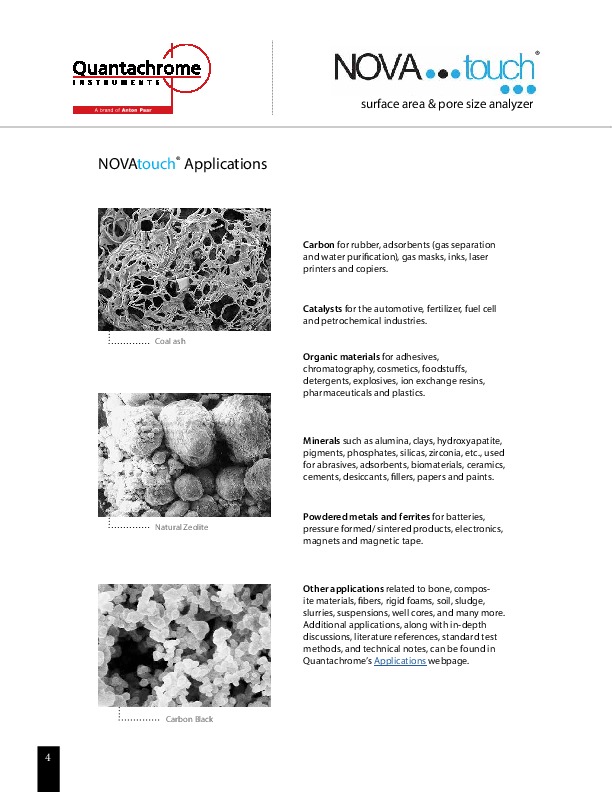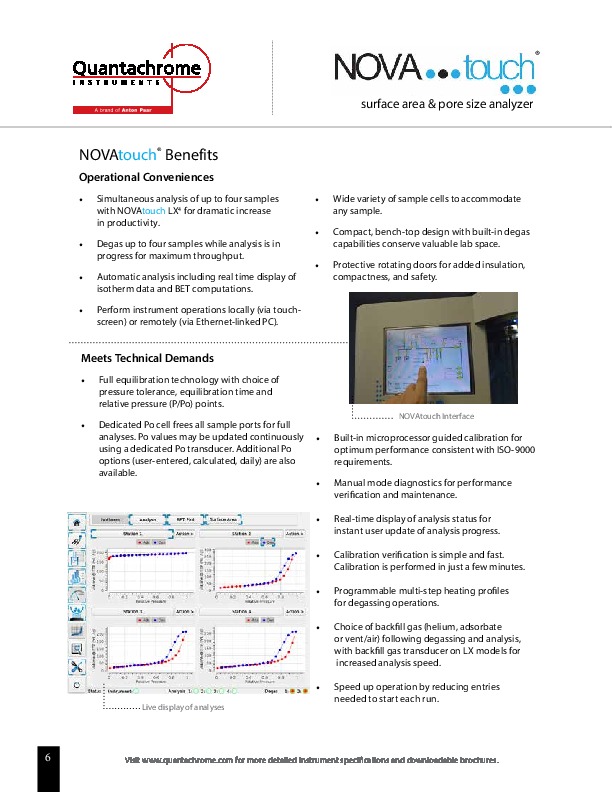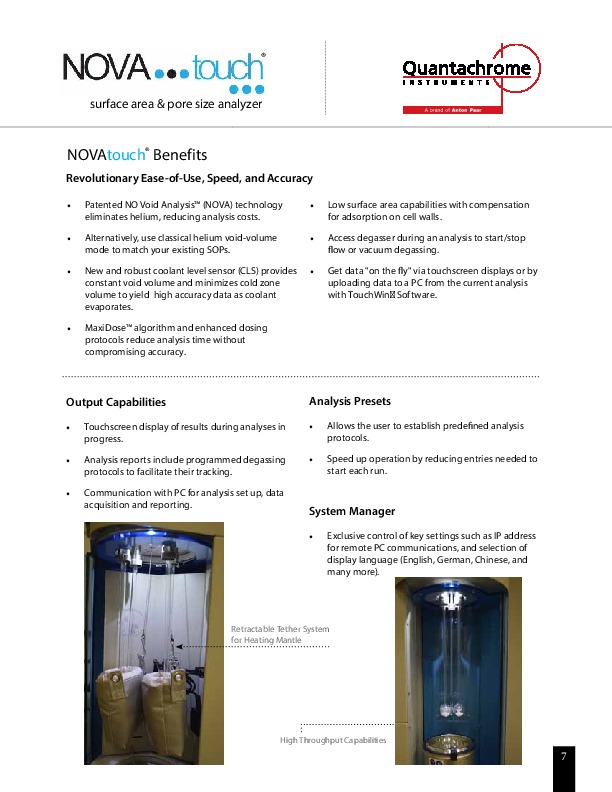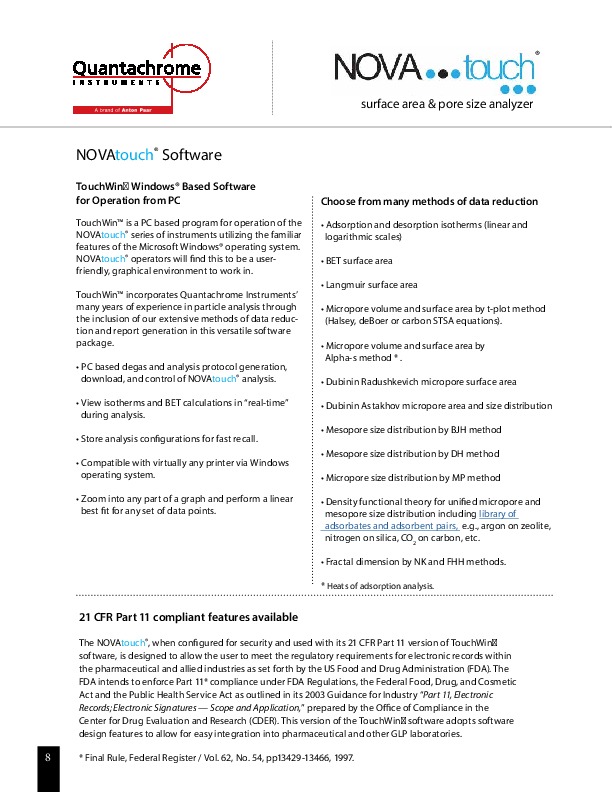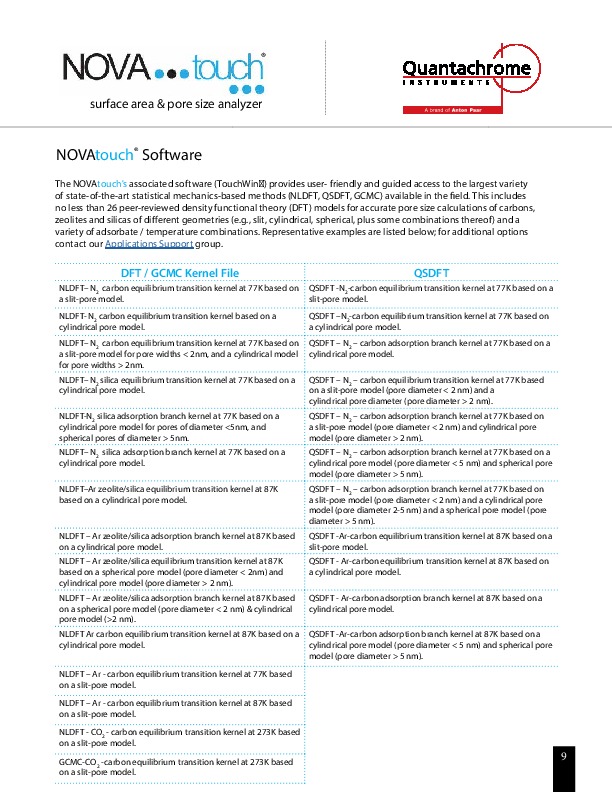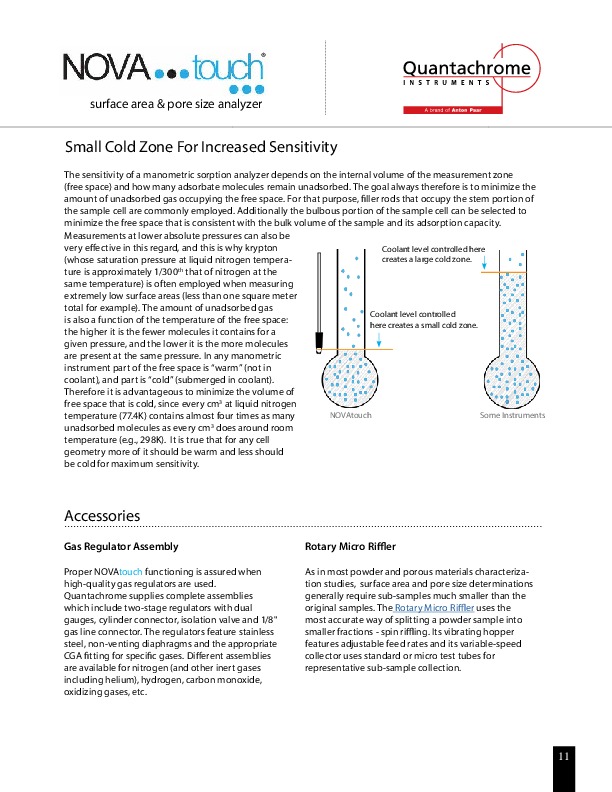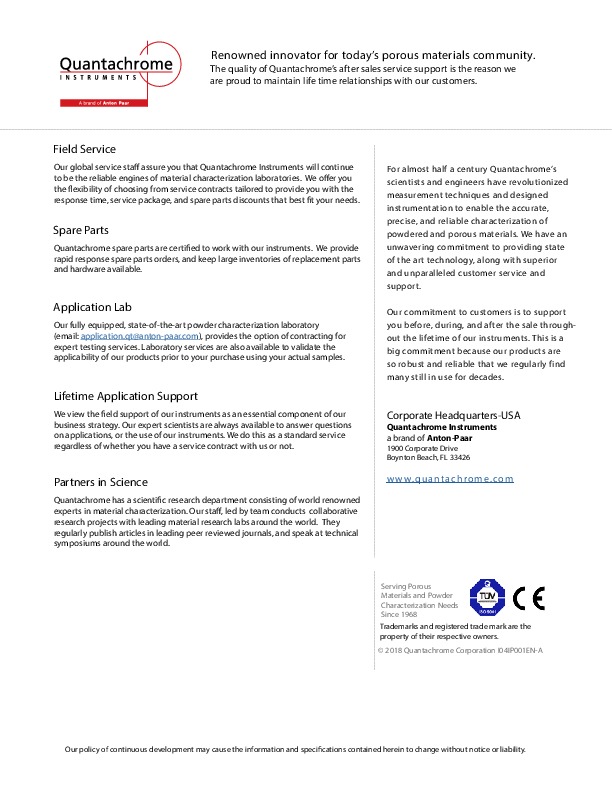Document
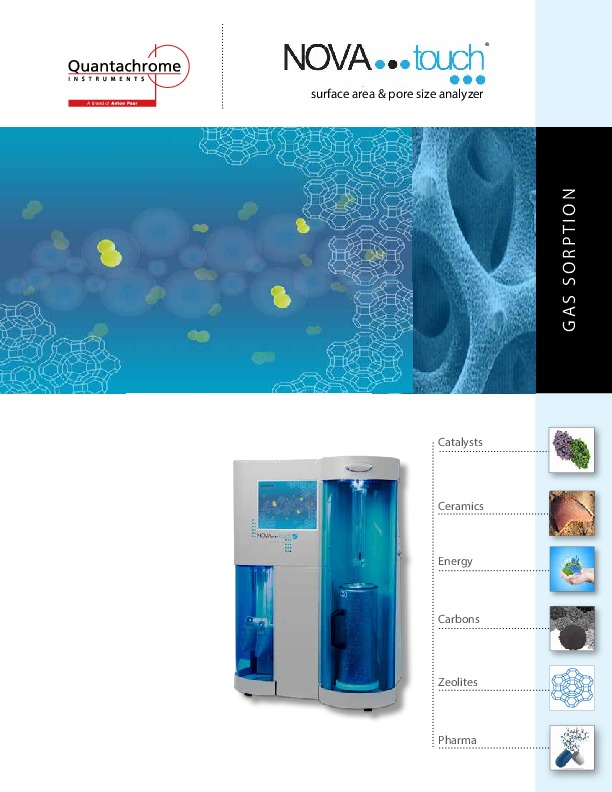
I04IP001EN_NOVATouch_Brochure

Contenu du document
Catalysts
Ceramics
Energy
Carbons
Zeolites
Pharma
surface area & pore size analyzer
®
GAS SORPTION
2
Quantachrome’s patented NOVAtouch series offers a full line of high-quality, high-performance gas sorption
analyzers, with two multi station models to meet the needs of any research or quality assurance laboratory.
N OVA touch ®
LX 2 rapid two sample surface area and pore size analyzer
• Perform fully automated multi-point B.E.T. analysis in as little as eight minutes.
• Eliminate the need for helium with patented NO Void Analysis™ (NOVA) technology.
• Analyze up to 2000 data points (1000 adsorption points and 1000 desorption points).
• Prepare four samples by vacuum or flow methods simultaneously with sample analysis.
• Access degasser during analysis to start / stop degassing.
• View data “on the fly” locally on the color touchscreen.
• Eliminate cell calibration with classical helium-void-volume mode.
• Transfer data via Ethernet connection.
• Enhance performance with Windows®-compatible software.
• Verify performance with rapid calibration check.
• Dedicated Po cell and transducer for greater analysis resolution and speed.
• Meets the special needs of busy research laboratories.
N OVA touch ®
LX 4 measures up to four samples simultaneously
• Analyze up to four samples at one time in addition to Po updates on a dedicated Po cell and transducer.
• Save space with four on-board sample preparation ports.
• Plus all the capabilities of the NOVA touch
LX 2.
NOVAtouch ® Overview
?
surface area & pore size analyzer
3
NOVAtouch ® Features
Feature Highlights of the NOVA touch
® Series*
Long Life Dewar
Analysis Ports (2 or 4)
Po Cell
5 Gas Input Ports
Coolant Level Sensor
Rotating Doors
Programmable
Heating Mantles Touchscreen
Ethernet Port
4 Degas Ports
Retracting Tethers
Function Capability by Model LX 2 LX4
Surface Area Analysis ?
?
Mesopore Size Distribution ?
?
Standard Micropore Analysis ?
?
Degassing Ports 44
Analysis Stations 24
Color Touchscreen ?
?
Live Graphical/Tabular Display of Analyses ?
?
Local and Remote PC Control ?
?
Extended Life Dewar ?
?
Robust Coolant Level Sensor ?
?
Flow Degassing ?
?
Vacuum Degassing ?
?
Dedicated Po Cell ?
?
Dedicated Po Transducer ?
?
Dedicated Backfill Transducer ?
?
?
surface area & pore size analyzer
4
Carbon for rubber, adsorbents (gas separation
and water purification), gas masks, inks, laser
printers and copiers.
Catalysts for the automotive, fertilizer, fuel cell
and petrochemical industries.
Organic materials for adhesives,
chromatography, cosmetics, foodstuffs,
detergents, explosives, ion exchange resins,
pharmaceuticals and plastics.
Minerals such as alumina, clays, hydroxyapatite,
pigments, phosphates, silicas, zirconia, etc., used
for abrasives, adsorbents, biomaterials, ceramics,
cements, desiccants, fillers, papers and paints.
Powdered metals and ferrites for batteries,
pressure formed/ sintered products, electronics,
magnets and magnetic tape.
Other applications related to bone, compos -
ite materials, fibers, rigid foams, soil, sludge,
slurries, suspensions, well cores, and many more.
Additional applications, along with in-depth
discussions, literature references, standard test
methods, and technical notes, can be found in
Quantachrome’s Applications webpage.
Coal ash
Natural Zeolite
Carbon Black
NOVA touch ® Applications
?
surface area & pore size analyzer
5
NOVAtouch ® Specifications
Performance: LX 2 LX 4
Analysis stations 24
Measurement types B.E.T., STSA, adsorption isotherm, desorption isotherm
Surface area range 0.01 m
2
/ g to no known upper limit
Pore size range 0.35 to 500 nm (3.5 to 5000 Å)
Minimum pore volume (liquid) 2.2 x 10
-6 ml / g
Minimum pore volume (STP) 0.0001 cc / g
Adsorbates:LX 2 LX 4
Nitrogen ? ?
Other non-corrosive gases (Ar, CO 2, H 2, C4H10, etc.) ??
Degassing:LX 2 LX 4
Preparation ports 4
Temperature range ambient - 450ºC*, 1ºC intervals
Programmable heating protocols Multi-step ramp rates / hold times
Pressure Transducers:LX 2 LX 4
Accuracy (% of span) ± 0 .1
A/D converter 24 -bit
Minimum pressure (mm Hg) resolution 6 x 10
-5
Minimum relative pressure P/Po (N 2) resolution6 x 10 -8
Physical:LX 2 LX 4
Dimensions (WxDxH) 61.6 cm x 49.2 cm x 82.9 cm
Weight 43 kg (95 lbs.)
Electrical 100-240 V, 50/60 Hz
*350ºC standard; 450ºC with optional heating mantles and quartz glassware.
.
?
surface area & pore size analyzer
6 Visit www.quantachrome.com for more detailed instrument specifications and downloadable brochures.
Operational Conveniences
• Simultaneous analysis of up to four samples
with NOVA touch LX 4 for dramatic increase
in productivity.
• Degas up to four samples while analysis is in
progress for maximum throughput.
• Automatic analysis including real time display of
isotherm data and BET computations.
• Perform instrument operations locally (via touch -
screen) or remotely (via Ethernet-linked PC). •
Wide variety of sample cells to accommodate
any sample.
• Compact, bench-top design with built-in degas
capabilities conserve valuable lab space.
• Protective rotating doors for added insulation,
compactness, and safety.
Meets Technical Demands
• Full equilibration technology with choice of
pressure tolerance, equilibration time and
relative pressure (P/Po) points.
• Dedicated Po cell frees all sample ports for full
analyses. Po values may be updated continuously
using a dedicated Po transducer. Additional Po
options (user-entered, calculated, daily) are also
available. •
Built-in microprocessor guided calibration for
optimum performance consistent with ISO-9000
requirements.
• Manual mode diagnostics for performance
verification and maintenance.
• Real-time display of analysis status for
instant user update of analysis progress.
• Calibration verification is simple and fast.
Calibration is performed in just a few minutes.
• Programmable multi-step heating profiles
for degassing operations.
• Choice of backfill gas (helium, adsorbate
or vent/air) following degassing and analysis,
with backfill gas transducer on LX models for
increased analysis speed.
• Speed up operation by reducing entries
needed to start each run.
NOVA touch ® Benefits
NOVAtouch Interface
Live display of analyses
?
surface area & pore size analyzer
7
Output Capabilities
• Touchscreen display of results during analyses in
progress.
• Analysis reports include programmed degassing
protocols to facilitate their tracking.
• Communication with PC for analysis set up, data
acquisition and reporting.
Analysis Presets
• Allows the user to establish predefined analysis
protocols.
• Speed up operation by reducing entries needed to
start each run.
System Manager
• Exclusive control of key settings such as IP address
for remote PC communications, and selection of
display language (English, German, Chinese, and
many more).
Revolutionary Ease-of-Use, Speed, and Accuracy
• Patented NO Void Analysis™ (NOVA) technology
eliminates helium, reducing analysis costs.
• Alternatively, use classical helium void-volume
mode to match your existing SOPs.
• New and robust coolant level sensor (CLS) provides
constant void volume and minimizes cold zone
volume to yield high accuracy data as coolant
evaporates.
• MaxiDose™ algorithm and enhanced dosing
protocols reduce analysis time without
compromising accuracy. •
Low surface area capabilities with compensation
for adsorption on cell walls.
• Access degasser during an analysis to start/stop
flow or vacuum degassing.
• Get data "on the fly" via touchscreen displays or by
uploading data to a PC from the current analysis
with TouchWin? Software.
NOVA touch ® Benefits
High Throughput Capabilities
Retractable Tether System
for Heating Mantle
?
surface area & pore size analyzer
8
To u c hW i n? Windows® Based Software
for Operation from PC
TouchWin™ is a PC based program for operation of the
N OVA touch ® series of instruments utilizing the familiar
features of the Microsoft Windows ® operating system.
N OVA touch
® operators will find this to be a user-
friendly, graphical environment to work in.
TouchWin™ incorporates Quantachrome Instruments’
many years of experience in particle analysis through
the inclusion of our extensive methods of data reduc -
tion and report generation in this versatile software
package.
• PC based degas and analysis protocol generation,
download, and control of NOVA touch
® analysis.
• View isotherms and BET calculations in “real-time”
during analysis.
• Store analysis configurations for fast recall.
• Compatible with virtually any printer via Windows
operating system.
• Zoom into any part of a graph and perform a linear
best fit for any set of data points.
Choose from many methods of data reduction
• Adsorption and desorption isotherms (linear and
logarithmic scales)
• BET surface area
• Langmuir surface area
• Micropore volume and surface area by t-plot method
(Halsey, deBoer or carbon STSA equations).
• Micropore volume and surface area by
Alpha-s method * .
• Dubinin Radushkevich micropore surface area
• Dubinin Astakhov micropore area and size distribution
• Mesopore size distribution by BJH method
• Mesopore size distribution by DH method
• Micropore size distribution by MP method
• Density functional theory for unified micropore and
mesopore size distribution including library of
adsorbates and adsorbent pairs, e.g., argon on zeolite,
nitrogen on silica, CO
2 on carbon, etc.
• Fractal dimension by NK and FHH methods.
*
Heats of adsorption analysis.
NOVA touch ® Software
21 CFR Part 11 compliant features available
T h e N OVA touch ®, when configured for security and used with its 21 CFR Part 11 version of TouchWin?
software, is designed to allow the user to meet the regulatory requirements for electronic records within
the pharmaceutical and allied industries as set forth by the US Food and Drug Administration (FDA). The
FDA intends to enforce Part 11* compliance under FDA Regulations, the Federal Food, Drug, and Cosmetic
Act and the Public Health Service Act as outlined in its 2003 Guidance for Industry “ Part 11, Electronic
Records; Electronic Signatures — Scope and Application, ” prepared by the Office of Compliance in the
Center for Drug Evaluation and Research (CDER). This version of the TouchWin? software adopts software
design features to allow for easy integration into pharmaceutical and other GLP laboratories.
* Final Rule, Federal Register / Vol. 62, No. 54, pp13429-13466, 1997.
?
surface area & pore size analyzer
9
The NOVAtouch's associated software (TouchWin ?) provides user- friendly and guided access to the largest variety
of state-of-the-art statistical mechanics-based methods (NLDFT, QSDFT, GCMC) available in the field. This includes
no less than 26 peer-reviewed density functional theory (DFT) models for accurate pore size calculations of carbons,
zeolites and silicas of different geometries (e.g., slit, cylindrical, spherical, plus some combinations thereof ) and a
variety of adsorbate / temperature combinations. Representative examples are listed below; for additional options
contact our Applications Support group.
DFT / GCMC Kernel File QSDFT
NLDFT– N 2 carbon equilibrium transition kernel at 77K based on
a slit-pore model. QSDFT -N 2-carbon equilibrium transition kernel at 77K based on a
slit-pore model.
NLDFT- N
2 carbon equilibrium transition kernel based on a
cylindrical pore model. QSDFT –N 2-carbon equilibrium transition kernel at 77K based on
a cylindrical pore model.
NLDFT– N
2 carbon equilibrium transition kernel at 77K based on
a slit-pore model for pore widths < 2nm, and a cylindrical model
for pore widths > 2nm. QSDFT – N 2 – carbon adsorption branch kernel at 77K based on a
cylindrical pore model.
NLDFT– N
2 silica equilibrium transition kernel at 77K based on a
cylindrical pore model. QSDFT – N 2 – carbon equilibrium transition kernel at 77K based
on a slit-pore model (pore diameter < 2 nm) and a
cylindrical pore diameter (pore diameter > 2 nm).
NLDFT-N
2 silica adsorption branch kernel at 77K based on a
cylindrical pore model for pores of diameter <5nm, and
spherical pores of diameter > 5nm. QSDFT – N 2 – carbon adsorption branch kernel at 77K based on
a slit-pore model (pore diameter < 2 nm) and cylindrical pore
model (pore diameter > 2 nm).
NLDFT– N
2 silica adsorption branch kernel at 77K based on a
cylindrical pore model. QSDFT – N 2 – carbon adsorption branch kernel at 77K based on a
cylindrical pore model (pore diameter < 5 nm) and spherical pore
model (pore diameter > 5 nm).
NLDFT–Ar zeolite/silica equilibrium transition kernel at 87K
based on a cylindrical pore model. QSDFT – N
2 – carbon adsorption branch kernel at 77K based on
a slit-pore model (pore diameter < 2 nm) and a cylindrical pore
model (pore diameter 2-5 nm) and a spherical pore model (pore
diameter > 5 nm).
NLDFT – Ar zeolite/silica adsorption branch kernel at 87K based
on a cylindrical pore model. QSDFT -Ar-carbon equilibrium transition kernel at 87K based on a
slit-pore model.
NLDFT – Ar zeolite/silica equilibrium transition kernel at 87K
based on a spherical pore model (pore diameter < 2nm) and
cylindrical pore model (pore diameter > 2 nm). QSDFT - Ar-carbon equilibrium transition kernel at 87K based on
a cylindrical pore model.
NLDFT – Ar zeolite/silica adsorption branch kernel at 87K based
on a spherical pore model (pore diameter < 2 nm) & cylindrical
pore model (>2 nm). QSDFT - Ar-carbon adsorption branch kernel at 87K based on a
cylindrical pore model.
NLDFT Ar carbon equilibrium transition kernel at 87K based on a
cylindrical pore model. QSDFT -Ar-carbon adsorption branch kernel at 87K based on a
cylindrical pore model (pore diameter < 5 nm) and spherical pore
model (pore diameter > 5 nm).
NLDFT – Ar - carbon equilibrium transition kernel at 77K based
on a slit-pore model.
NLDFT – Ar - carbon equilibrium transition kernel at 87K based
on a slit-pore model.
NLDFT - CO
2 - carbon equilibrium transition kernel at 273K based
on a slit-pore model.
GCMC-CO
2 -carbon equilibrium transition kernel at 273K based
on a slit-pore model.
NOVA touch ® Software
?
surface area & pore size analyzer
10
Before performing gas sorption exper-
iments, solid surfaces must be freed
from contaminants such as water and
oils. Surface cleaning (degassing) is most
often carried out by placing a sample
of the solid in a glass cell and heating it
under vacuum or flowing gas. Figure 1
Illustrates how a solid particle containing
cracks and orifices (pores) of different
sizes and shapes may look after its pre -
treatment.
Once clean, the sample is brought to a
constant temperature by means of an
external bath. Then, small amounts of a
gas (the adsorbate) are admitted in steps
into the evacuated sample chamber. Gas
molecules that stick to the surface of the
solid (adsorbent) are said to be adsorbed
and tend to form a thin layer that covers
the entire adsorbent surface. Based on
the well-known Brunauer, Emmett and
Teller (B.E.T.) theory, one can estimate the
number of molecules required to cover
the adsorbent surface with a monolayer
of adsorbed molecules, N
m (see Figure
2 ). Multiplying N
m by the cross-sectional
area of an adsorbate molecule yields the
sample’s surface area.
Continued addition of gas molecules
beyond monolayer formation leads to
the gradual stacking of multiple layers
(or multilayers). Their formation occurs in
parallel to capillary condensation
(see Figure 3 ). The latter process is approximated by the Kelvin equation,
which quantifies the proportionality
between residual (or equilibrium) gas
pressure and the size of capillaries
capable of condensing gas within them.
Methods such as the classical one by
Barrett, Joyner and Halenda (B.J.H.), or
the more accurate Density Functional
Theory (DFT) models, allow the com-
putation of pore sizes from equilibrium
gas pressures. Experimental isotherms
of adsorbed gas volumes versus relative
pressures (at equilibrium) are converted
to cumulative or differential pore size
distributions.
As the equilibrium adsorbate pressures
approach saturation, the pores become
completely filled with adsorbate
(see Figure 4 ).
Knowing the density of the adsorbate,
one can calculate the volume it occupies
and, consequently, the total pore volume
of the sample. If at this stage the adsorp -
tion process is reversed by withdrawing
known amounts of gas from the system
in steps, one generates desorption
isotherms. The resulting hysteresis leads
to isotherm shapes that can be related
to those expected from particular pore
shapes.
The Gas Sorption Process
Industries Served
Particle characterization
technology serves a wide
variety of industries,
including:
• Aerospace
• Agriculture
• Automotive
• Aviation
• Batteries
• Building Materials
• Ceramics
• Chemicals
• Communications
• Construction
• Consumer Goods
• Cosmetics
• Electrical
• Electronics
• Environmental
• Foods
• Food Processing
• Fuel Cells
• Manufacturing
• Marine
• Medical Devices
• Metals
• Mining & Minerals
• Munitions
• Oil Exploration
• Optics
• Paints & Coatings
• Paper & Packaging
• Petrochemicals
• Pharmaceuticals
• Plastics
• Rubber
• Te x t i l e s
• Water Treatment
1
A section of one
greatly enlarged
particle of a solid.
2
The monolayer of
adsorbed molecules; approximately
20% saturation.
3
The multilayer / capillary condensation stage;
approximately
70% saturation.
4
Total pore volume
filling; approximately
100% saturation.
?
surface area & pore size analyzer
11
Gas Regulator Assembly
Proper NOVAtouch functioning is assured when
high-quality gas regulators are used.
Quantachrome supplies complete assemblies
which include two-stage regulators with dual
gauges, cylinder connector, isolation valve and 1/8"
gas line connector. The regulators feature stainless
steel, non-venting diaphragms and the appropriate
CGA fitting for specific gases. Different assemblies
are available for nitrogen (and other inert gases
including helium), hydrogen, carbon monoxide,
oxidizing gases, etc.
Rotary Micro Riffler
As in most powder and porous materials characteriza -
tion studies, surface area and pore size determinations
generally require sub-samples much smaller than the
original samples. The Rotary Micro Riffler uses the
most accurate way of splitting a powder sample into
smaller fractions - spin riffling. Its vibrating hopper
features adjustable feed rates and its variable-speed
collector uses standard or micro test tubes for
representative sub-sample collection.
Small Cold Zone For Increased Sensitivity
Coolant level controlled
here creates a small cold zone.
Coolant level controlled here
creates a large cold zone.
Some Instruments
N OVAtouch
Measurements at lower absolute pressures can also be
very effective in this regard, and this is why krypton
(whose saturation pressure at liquid nitrogen tempera -
ture is approximately 1/300
th that of nitrogen at the
same temperature) is often employed when measuring
extremely low surface areas (less than one square meter
total for example). The amount of unadsorbed gas
is also a function of the temperature of the free space:
the higher it is the fewer molecules it contains for a
given pressure, and the lower it is the more molecules
are present at the same pressure. In any manometric
instrument part of the free space is “warm” (not in
coolant), and part is “cold” (submerged in coolant).
Therefore it is advantageous to minimize the volume of
free space that is cold, since every cm
3 at liquid nitrogen
temperature (77.4K) contains almost four times as many
unadsorbed molecules as every cm
3 does around room
temperature (e.g., 298K). It is true that for any cell
geometry more of it should be warm and less should
be cold for maximum sensitivity.
The sensitivity of a manometric sorption analyzer depends on the internal volume of the measurement zone
(free space) and how many adsorbate molecules remain unadsorbed. The goal always therefore is to minimize the
amount of unadsorbed gas occupying the free space. For that purpose, filler rods that occupy the stem portion of
the sample cell are commonly employed. Additionally the bulbous portion of the sample cell can be selected to
minimize the free space that is consistent with the bulk volume of the sample and its adsorption capacity.
Accessories
?
surface area & pore size analyzer
For almost half a century Quantachrome’s
scientists and engineers have revolutionized
measurement techniques and designed
instrumentation to enable the accurate,
precise, and reliable characterization of
powdered and porous materials. We have an
unwavering commitment to providing state
of the art technology, along with superior
and unparalleled customer service and
support.
Our commitment to customers is to support
you before, during, and after the sale through-
out the lifetime of our instruments. This is a
big commitment because our products are
so robust and reliable that we regularly find
many still in use for decades.
Corporate Headquarters-USA
Quantachrome Instruments
a brand of Anton-Paar
1900 Corporate Drive
Boynton Beach, FL 33426
www.quantachrome.com
Field Service
Our global service staff assure you that Quantachrome Instruments will continue
to be the reliable engines of material characterization laboratories. We offer you
the flexibility of choosing from service contracts tailored to provide you with the
response time, service package, and spare parts discounts that best fit your needs.
Spare Parts
Quantachrome spare parts are certified to work with our instruments. We provide
rapid response spare parts orders, and keep large inventories of replacement parts
and hardware available.
Application Lab
Our fully equipped, state-of-the-art powder characterization laboratory
(email: application.qt@anton-paar.com), provides the option of contracting for
expert testing services. Laboratory services are also available to validate the
applicability of our products prior to your purchase using your actual samples.
Lifetime Application Support
We view the field support of our instruments as an essential component of our
business strategy. Our expert scientists are always available to answer questions
on applications, or the use of our instruments. We do this as a standard service
regardless of whether you have a service contract with us or not.
Partners in Science
Quantachrome has a scientific research department consisting of world renowned
experts in material characterization. Our staff, led by team conducts collaborative
research projects with leading material research labs around the world. They
regularly publish articles in leading peer reviewed journals, and speak at technical
symposiums around the world.
Our policy of continuous development may cause the information and speciffcations contained herein to change without notice or liability.
The quality of Quantachrome’s after sales service support is the reason we
are proud to maintain life time relationships with our customers.
Renowned innovator for today’s porous materials community.
Trademarks and registered trade mark are the
property of their respective owners. Serving Porous
Materials and Powder
Characterization Needs
Since 1968
? 2018 Quantachrome Corporation I04IP001EN-A
Entreprises concernées :
Produits concernés :
Date d'upload du document :
mardi 12 janvier 2021


